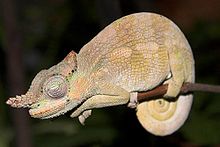Kinyongia: Difference between revisions
Lyttle-Wight (talk | contribs) →Species: Add more species, with citation. |
Lyttle-Wight (talk | contribs) →Species: Explain use of parentheses. |
||
| Line 31: | Line 31: | ||
*''[[Kinyongia vosseleri]]'' {{small|(Nieden, 1913)}} – East Usambara two-horned chameleon |
*''[[Kinyongia vosseleri]]'' {{small|(Nieden, 1913)}} – East Usambara two-horned chameleon |
||
*''[[Kinyongia xenorhina]]'' {{small|(Boulenger, 1901)}} – strange-nosed chameleon |
*''[[Kinyongia xenorhina]]'' {{small|(Boulenger, 1901)}} – strange-nosed chameleon |
||
''[[Nota bene]]'': A [[Binomial nomenclature|binomial authority]] in parentheses indicates that the species was originally described in a genus other than ''Kinyongia''. |
|||
==References== |
==References== |
||
Revision as of 10:29, 24 May 2017
| Kinyongia | |
|---|---|

| |
| Sleeping dwarf two-horned chameleon (K. tavetana) | |
| Scientific classification | |
| Domain: | Eukaryota |
| Kingdom: | Animalia |
| Phylum: | Chordata |
| Class: | Reptilia |
| Order: | Squamata |
| Suborder: | Iguania |
| Family: | Chamaeleonidae |
| Genus: | Kinyongia Tilbury, Tolley and Branch, 2006 |
Kinyongia (derived from the species' name in Kiswahili language)[1] is a chameleon genus recently established for several plesiomorphic species found in forest and woodland in Kenya, Tanzania, Uganda, Rwanda, and far eastern DR Congo. All except K. adolfifriderici and K. tavetana are restricted to highlands and many have very small distributions. In most, at least the males have horns or knobs on their noses. They were erroneously placed into Bradypodion for some time.[2][3] It has recently been pointed out that the ending to the specific epithet in several of the below listed species should be modified to match the feminine genus name.[4]
Species
The following 20 species are recognized as being valid.[5]
- Kinyongia adolfifriderici (Sternfeld, 1912) – Ituri chameleon
- Kinyongia asheorum Necas et al., 2009 – Mount Nyiro bearded chameleon
- Kinyongia boehmei (Lutzmann & Necas, 2002) – Boehme's chameleon
- Kinyongia carpenteri (Parker, 1929) – Carpenter's chameleon
- Kinyongia excubitor (Barbour, 1911) – Mt. Kenya hornless chameleon
- Kinyongia fischeri (Reichenow, 1887) – Fischer's chameleon
- Kinyongia gyrolepis Greenbaum et al., 2012 – Lendu chameleon
- Kinyongia magomberae Menegon et al., 2009 – Magombera chameleon
- Kinyongia matschiei (F. Werner, 1895) – giant monkey-tailed East Usambara two-horned chameleon
- Kinyongia msuyae Menegon et al., 2015
- Kinyongia multituberculata (Nieden, 1913) – West Usambara two-horned chameleon
- Kinyongia mulyai Tilbury & Tolley, 2015
- Kinyongia oxyrhina (Klaver & W. Böhme, 1988) – sharp-nosed chameleon
- Kinyongia tavetana (Steindachner, 1891) – dwarf Fischer's chameleon, dwarf two-horned chameleon
- Kinyongia tenuis (Matschie, 1892) – Usambara soft-horned chameleon
- Kinyongia ulugurensis (Loveridge, 1957) – Uluguru two-horned chameleon
- Kinyongia uthmoelleri (L. Müller, 1938) – Hanang hornless chameleon
- Kinyongia vanheygeni Necas, 2009 – Van Heygen's chameleon
- Kinyongia vosseleri (Nieden, 1913) – East Usambara two-horned chameleon
- Kinyongia xenorhina (Boulenger, 1901) – strange-nosed chameleon
Nota bene: A binomial authority in parentheses indicates that the species was originally described in a genus other than Kinyongia.
References
- ^ "Some Important Changes in the Systematics of Bradypodion. Kinyongia is derived from the species name in Kiswahili language". Chameleons Online E-Zine. Retrieved 2012-09-24.
- ^ Klaver, C.J.J. & Böhme, W. (1986): Phylogeny and classification of the Chamaeleonidae (Sauria) with special reference to hemipenis morphology. Bonner Zoologische Monographien 22: 1–64.
- ^ Tolley, Krystal A.; Tilbury, Colin R. & Branch, William R. (2004): Phylogenetics of the southern African dwarf chameleons, Bradypodion (Squamata: Chamaeleonidae). Molecular Phylogenetics and Evolution 30: 354–365. doi:10.1016/S1055-7903(03)00211-2 PDF fulltext Archived 2007-02-02 at the Wayback Machine
- ^ Tolley, Krystal A.; Tilbury, Colin R. & Branch, William R. (2007): Corrections to species names recently placed in Kinyongia and Nadzikambia (Reptilia: Chamaeleonidae). Zootaxa 1426: 68.
- ^ "Kinyongia ". The Reptile Database. www.reptile-database.org.
- Necas, P., R. Sindaco, K. Ludék, J. Kopečná, P. K. Malonza, D. Modrý (2009): Kinyongia asheorum sp. n., a new montane chameleon from the Nyiro Range, northern Kenya (Squamata: Chamaeleonidae). Zootaxa: 41-50.
